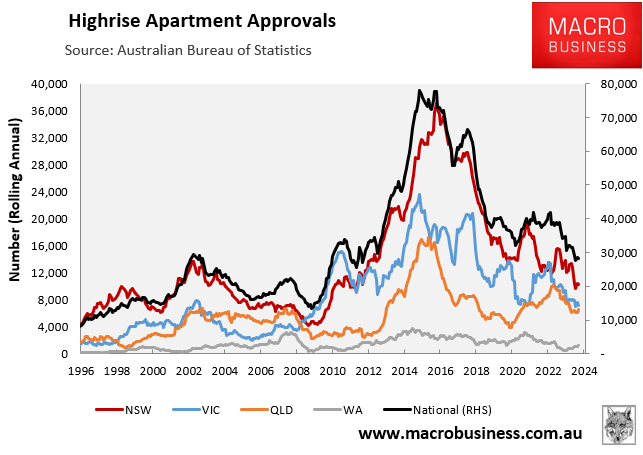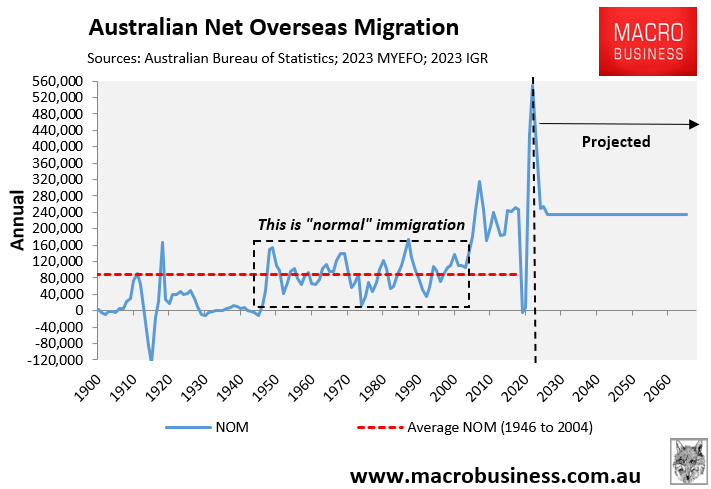Buying a new high-rise apartment in Australia is a game of financial Russian Roulette.
The second half of last decade saw the greatest high-rise construction boom in Australia’s history.

In recent years, hundreds of these buildings have been required to remove potentially combustible cladding, at a cost of millions of dollars.
There have also been structural issues with many apartment towers, costing owners millions of dollars in repairs.
In 2019, Four Corners aired a story titled Cracking Up, which revealed systemic issues with construction quality across the nation’s apartment market.
“We’ve got a real problem here. It’s systemic and it’s infecting lots of buildings across the landscape, in all parts of the country. It’s very clear”, one building analyst told Four Corners in 2019.
“I have never seen a building that isn’t defective in some way. I know it’s my job, but even just walking around in public, I notice these things”, a forensic engineer added.
In 2021, The Age reported that “City high-rise residents fear for safety amid ‘terrifying’ creaking”.
The report explained how residents of two high-rise apartment complexes in Melbourne complained about cracking and banging noises that were so bothersome that they were causing mental health difficulties and prompted some to sell their units.
The problems at the Australia 108 skyscraper had not been fixed, and occupants at two other towers, Multiplex’s Melbourne Square in Southbank and UEM Sunrise’s Aurora building on La Trobe Street, were reported to be experiencing similar issues.
It is a similar situation in New South Wales where a government strata study released in November 2023 found that more than half (53%) of newly registered buildings had “serious defects”.
The share of complexes with severe defects had also more than doubled since the 2021 survey.
A separate study by the Strata Community Association NSW found that waterproofing was the most common major issue, followed by fire safety.
Another Four Corners report, titled “The Strata Trap” documented how apartment owners are being slugged by excessive body corporate fees.
“It’s almost as if the whole business model has been designed to frankly screw Australian apartment owners”, one Sydney apartment owner told Four Corners.
The NSW and Victorian governments are now conducting a full court press to liberalise planning and encourage the construction of swathes of high-rise towers across established inner and middle-ring suburbs.
The NSW Productivity and Equality Commission recommended higher towers, smaller apartments, less storage and natural light, smaller balconies, and fewer car spaces as the solution to the state’s housing crisis:

“Higher-density zones around train stations would double in size”, the ABC reported.
“The NSW productivity commissioner is also recommending design standards be relaxed to allow the construction of smaller apartments without access to parking, storage or direct sunlight”.
“The commission has also recommended minimum apartment size requirements be removed, to improve feasibility for developers and affordability for buyers”.
“Balcony size rules, storage requirements, and guidelines for “family-sized” units were also unnecessary, the commission found”.
The Victorian government last week announced that 50 activity centres near transport hubs across Melbourne’s suburbs would be zoned to accommodate apartment towers of up to 20 storeys.
This has prompted warnings from experts that apartment quality could suffer in the rush to supply the market.
“These apartments will be around a long time beyond the current conditions”, Jane Keddie, vice-president of the Planning Institute of Australia’s Victorian division, said.
“We’re concerned that there’s a narrative around reducing standards to improve development feasibility”.
“There is a risk that we will continue to build homes that don’t provide as compelling an alternative to the sort of amenity we expect of a single home or a townhouse”, Urban Design Forum’s Andy Fergus said.
“We need to think about these as forever homes. If they’re a massive part of our future city’s landscape, we need to treat them that way”.
“They’re clearly just very, very fixated on housing supply and I think the worry is that we’re making very quick decisions that will have very permanent effects on our city”.
“Taller buildings need wider streets, more public space, larger lots”, Fergus said.
“I have concerns about the heights being proposed in combination with the lack of a comprehensive urban design process”, SGS Economics and Planning senior associate Andrew Spencer said.
“Speeding up planning in these activity centres will deliver little benefit if the result is a housing product that costs too much and doesn’t meet the utility of buyers”, developer Max Shifman said.
Last year, building construction lawyer Bronwyn Weir warned that accelerating construction to meet the government’s housing target would inevitably result in corners being cut, poorer quality, and defects.
“On current estimates, 50% of what will be built will have serious defects”, Weir said.
Similarly, Torrens University academics warned that “as the Albanese government fast-tracks its five-year plan to build 1.2 million dwellings”, the prevalence of serious defects in apartment buildings “will likely worsen”.
Accelerating apartment construction to meet the federal government’s rapid immigration-driven population growth will yield similar outcomes to last decade’s high-rise boom.
Build quality will deteriorate, culminating in the construction of thousands more defective high-rise shoebox apartments across Sydney and Melbourne.
Congestion will also increase throughout Sydney’s and Melbourne’s economic and social infrastructure, limiting resident access to roads, hospitals, schools, parks, and other public services.
Rather than continuing down this ‘grow at all costs’ path, the New South Wales and Victorian governments should instead demand that the federal government reduce net overseas migration to levels commensurate with the country’s capabilities to provide new housing and infrastructure.

Voters have never supported mass immigration, and the vast majority of Australians are against it. They also categorically do not want to live in high rises.
Our policymakers must stop inundating our cities with huge volumes of people, crush-loading our housing, infrastructure, water supplies, and living standards.
We have already seen how this story will end, courtesy of last decade’s unprecedented apartment boom, which was riddled with defects.
Let’s not repeat it.

